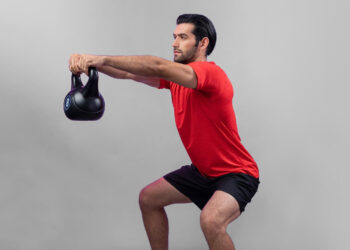Pauses / Adding 1/2 Rep / Tempo Lifting / EMOM for Strength / Wrapping Up
Progress in the weight room is never in a straight line. There are times when you’re crushing it and making rapid gains. You look in the mirror and you’re pleased with what you see.
Then, there are other times when you and the barbell butt heads, and you dislike what you see. And no matter what you do, you’re stuck.
It’s a lifter’s worst nightmare, the dreaded lifting plateau.
And when you’ve been lifting for a while, you’ll experience one. Then the trick is to find a way to break through it when it happens to you.
And when it happens, use the following 4 methods that will get your stronger, build muscle and leave your plateaus in the dust.
Level Up Your Fitness: Join our 💪 strong community in Fitness Volt Newsletter. Get daily inspiration, expert-backed workouts, nutrition tips, the latest in strength sports, and the support you need to reach your goals. Subscribe for free!
So, the next time your frustrated and the plateau seems to big to overcome, these 4 simple tweaks will get the barbell moving in the right direction again.
1. Pauses
The three main triggers for hypertrophy are mechanical tension, metabolic stress, and muscle damage and adding a pause to your lifts covers all three of these bases. (1)
However, be warned, pauses don’t tickle.
Because adding a pause while the working muscle is under tension will have you hating life in a hurry. Which means you’ll be busting through your plateau in no time.
Pauses work well with both compound lifts like deadlifts, squats, presses, and rows (as accessory training after your main lift) and isolation exercises to bring up a lagging muscle group.
When pausing, it’s best to do it in the most difficult position when the working muscles are under the most tension. For the squat, it’s the bottom position (the hole).
For the bench press, it’s just above the chest and for the deadlift, it’s off the floor, below the knees.
For example:
1A. Paused barbell squat (pausing in the hole) 6-8 reps
1B. Hip Flexor Stretch 30 seconds each side
A 3-second pause with a load between 60-80% 1 RM, and 6- 10 reps works well. However, add reps before you add weight. Tension and technique are the keys here.
Or for isolation exercises, pairing in a superset that trains the opposite muscle group works well. For example:
1A. Alternating dumbbell biceps curl (pausing for 3-5 seconds when the elbow is bent at 90 degrees) 12-15 reps
1B. Triceps extension variation 12 – 15 reps
2. Adding 1/2 Rep
You take an exercise and “extend” the set by adding a 1/2 rep in between a full range of motion repetition.
Adding a 1/2 rep during most strength training exercises reps will increase your muscles time under tension, helping you ‘feel’ the exercise more and addressing any technique flaw or weakness in the lift
For example, if you’re having trouble at the bottom of your bench press adding half a rep will build more strength there.
This works with accessory exercises such as single-leg exercises, row and pressing variations because you’re adding more time under tension, to help build up strength( and muscle) which is great for building up a lagging body part too.
For example:
1A. Bulgarian split squat with a rep in half 8-12 reps
1B. Single leg hip extensions 8-12 reps
When you’re using this method, don’t be a hero and lower your usual working weight for the exercise by 10 pounds or more because adding 1/2 rep will have you feeling the burn in a big way. Working in a rep range of 6-12 will suffice.
3. Tempo Lifting
Ever looked at a program and seen these 4 numbers- 3131? Is it some sort of code? No, it’s lifting tempo and each of those 4 numbers represents a different part of the lift.
The first number is the eccentric (lowering) part. The second is the bottom position, the third is the concentric (lifting) part of the movement, and the fourth is the top position.
Consider the tempo of 3131 for a squat—it takes 3 seconds to lower into the bottom of your squat. Then a pause of 1 second at the bottom, followed by 3 seconds to stand back up, and 1 second to pause at the top.
And you can manipulate this according to your goals. For example, if you’re having trouble controlling the eccentric part of the bench press, lightening the weight and using a 3-5 eccentric will help.
For example:
1A. Barbell bench press – 4121 tempo 6 reps
1B. Band pull apart 15 reps
Lifting with tempo encourages you to slow things down and focus on your form. Any hitches in the lift will be easier to spot if you’re going slow rather than fast. Furthermore, you’ll have more time under tension, which is a key component in building strength and muscle. (2)
For compound movements, using 70-80% 1 RM for 6-12 reps (depending on load) is a good starting point.
4. EMOM for Strength
Every minute on the minute sets is often used with metabolic training and workout finishers at the end of the training. Using lightweight or bodyweight exercises, it’s you against the clock. It’s a great conditioning tool and it holds you accountable to do a certain amount of work against the clock.
But these can be used for strength too because strength is a skill also that needs to be practiced. Working with a heavy load while being on the clock allows you to spend some quality time with the barbell.
Instructions
Load a barbell with 90% 1 RM for lifts such as squats, deadlifts, presses or pulls. Set the stopwatch for anywhere between 10 – 20 minutes and do one rep every minute on the minute. And if it takes you 10 seconds to set up for a rep, please take this into account.
However, this is a demanding form of training and should only be done with one lift per workout. And if there is any breakdown in form, please stop.
This is best done periodically to shake things up so you can improve your 1 RM.
Wrapping up
The key to busting through plateaus is spending more time under tension (TUT), lifting with submaximal weights and focusing on weaker points within a lift to clean up your technique.
Because there’s no need for tricky when you have these methods at your disposal.
References
1. J Strength Cond Res. 2010 Oct;24(10):2857-72 The mechanisms of muscle hypertrophy and their application to resistance training. Schoenfeld BJ1.
2. Neuro Endocrinol Lett. 2018 Mar;39(1):26-32. Physiological responses to different neuromuscular movement task during eccentric bench press. Wilk M1, Stastny P2, Golas A1, Nawrocka M1, Jelen K3, Zajac A1, Tufano JJ2.









